








Orthodox Church in America
Diocese of the South
65 Spinner Lane
Wagener, SC 29164 - USA
telephone: 803-564-6894
email address:
Mary_MarthaM@pbtcomm.net
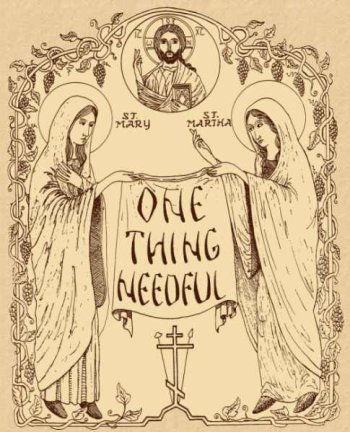

         Saints Mary & Martha
Orthodox Monastery
Orthodox Church in America Diocese of the South 65 Spinner Lane Wagener, SC 29164 - USA telephone: 803-564-6894 email address: Mary_MarthaM@pbtcomm.net |
  |
|
See old newsletters
ONE THING NEEDFUL
JANUARY 2011 BE ALL THAT GOD WANTS YOU TO BE
Our world is full of options and we are encouraged: “Be all that you can be!”. We struggle to make choices which will bring happiness, peace, prosperity, health . . . but like the young man in the Gospel we are not satisfied and ask “What more must I do?” When it is time for major life decisions (education, job, marriage, medical . . .) we ask – or should – what does God want me to do. Our good God wants the best for us and has left us free to make our choices. He will never abandon us and, being All-powerful, can bring good out of our wrong choices. We need the trust of a child as Christ admonished His disciples: unless you become as a little child . . . Therefore, let us work each day at all the myriad decisions we make to bring God’s Presence into our consciousness. As our relationship with God grows, we recognize His love and care of us in each moment, see what He wants, surrender to it, and be all that God wants us to be.  MONASTERY NEWS
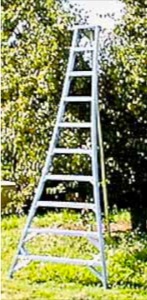 Photo from Tallman Ladders’ website Looking at the last three months, we continue to realize that doing each day what the Lord puts before us is the way this monastery will be built. With the harvesting of the fruit trees this fall, we knew that we needed a 16’ orchard ladder (tripod ladder). The closest place to purchase one of these ladders was Dalton Equipment Company in Hendersonville, North Carolina. So when one of us made the trip to Hendersonville for the Southeastern Animal Fiber Fair at the end of October, she purchased one for the monastery and brought it back tied to the roof of the van. On November 10th, Fr. Ernesto Rios and Madrecita Marta brought Drew Whitesell’s body here for burial. His son and girlfriend, being from New Jersey came to visit his grave on January 10th when we had 6” of icy snow. They brought with them the ashes of Drew’s parents, William and Elizabeth Whitesell which were buried in the same gravesite. May their memory be eternal! We are always grateful to those who volunteer their time and talents to help out with the work here. Having had three pieces of an antique, wrought-iron gate sand blasted and sealed, we were blessed with some strong people to help move them from the bed of the pick-up to the side of the red shed. Several fallen trees were cut up into fire wood for the hermitage. A 10”x10”x12’ post was set into the ground, and the large chimes were hung on it. Candle stubs were cleaned for recycling. The ceiling fan in the back room was replaced. Two large shrubs were planted to replace the two that had died. Four loads of two-year-old horse manure were unloaded. Some of the kitchen cabinets were cleaned out and reorganized. The ramp door, which, for some time, had to be opened by kicking or body slamming it and closed with much difficulty was replaced after the doorknob came off. Recently we found an iron worker who would repair the gate to Candle Shop Lane. Weather permitting, we hope that he will re-install it in the next week or two. 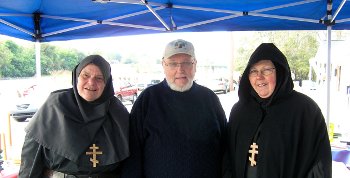 Mother Helena, Bruce Rickerson, & Sister Lyubov under our tent at Saint Nicholas Festival While it is a “long haul” to save enough money to begin building the large monastery, this past quarter has been a real boost for our morale. The flea market on November 13th brought in $214.92. We raised $1161.35 at the St. Nicholas Festival at Holy Apostles Orthodox Church on December 4th. A sizable amount of this came from the sale of vintage costume jewelry. Also, many of you remembered us over the past quarter, and, thanks be to God, we were able to add these gifts to our building fund. Thanksgiving and Christmas were fairly quiet with Liturgies, other prayer services, friends and feasting. Roasted salmon and homemade ravioli are among our most favorite main dishes. Prayers, welcoming guests, candle making, First Saturday Liturgies, gardening, and simply taking care of whatever is put before us continues unabated. Recently, when one of us made our usual trip to the local feed and seed store for bird food, another customer greeted her with, “Howdy Sister, how ya doin’?”. To which she answered, “Well, by God’s grace.” He replied back, “That’s a mighty fetchin’ outfit you have on there.” We loved it. 
 CHRISTIANITY IN KIEV BEFORE VLADIMIR THE GREAT
Part 1 St. Paul’s words to the Corinthians, “I planted, Apollos watered, but God gave the increase. So then neither he who plants is anything, nor he who waters, but God who gives the increase. Now he who plants and he who waters are one, and each one will receive his own reward according to his own labor. For we are God’s fellow workers.” (I Corinthians 3:6-9a) (NKJ) When we read about the conversion of Russia to Eastern Christianity, we immediately think of St. Vladimir the Great of Kiev (Kyiv) and the year 988 when much of the population of Kievan Rus was baptized. Yes, this was a great event in the annals of Byzantine/Russian history. But, was it as instantaneous as most accounts portray it to be? We learn from these same pages of history that Princess Olga (d. 969), Vladimir’s grandmother, influenced him greatly, but little else is generally said of her. What did Olga, Princess of Kiev, do, if anything, to influence her people to convert to Christianity? It is well known that her son, Sviatoslav, tenaciously remained a pagan to the end of his days. Were Christians in Kiev before Princess Olga? Were Christians in Kiev before the reigns of Prince Askold or Prince Dir a century earlier? Where does our story begin? For millennia people have conducted trade along waterways, and the Dnieper River which flows by Kiev was no exception. Starting in the late seventh century before Christ, the Greeks began establishing colonies around the Black Sea. Tyras, one of those colonies, was situated near the mouth of the Tyras River (present day Dnieper River). By the first century of our Lord Jesus Christ, the Roman Empire was vast and included southern Samatia (present day Ukraine). Rome prided itself on infrastructure by building roads, securing sea routes, and strengthening or rebuilding strategic trading centers so that trade goods were funneled into them to collect taxes. One of those trading centers was Tyras, which was destroyed by the Getae in 50 BC and rebuilt by the Romans by 56 AD. Tryas’ long trading history linked the peoples of the Dnieper River and further north to those of the Greek colonies around the Black Sea (Byzantium being one) to the Roman Empire and beyond. 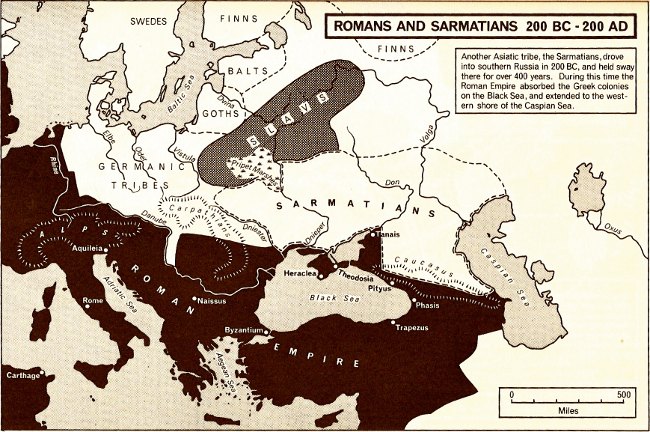 Atlas of Russian History , Page 4 After Pentecost, the twelve Apostles gathered together and drew lots to see who would take the Gospel message of Christ to different parts of the earth. To Andrew, the First Called Apostle, fell the lot that included Macedonia, Thrace, the cities and towns around the Sea of Marmara and the Black Sea, and the lands east of the Black Sea. This included peoples on the Dnieper River (the western region of Samatia, now part of the Ukraine) as well as other tributaries that flow into the Black Sea. With the help and protection of the Holy Spirit, he traveled extensively, preached the Gospel, worked miracles, baptized those who embraced Christ and His teachings, established churches, consecrated bishops, and endured all for Christ sake. Historical accounts state that Andrew was gone a long time. 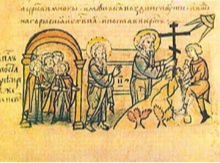 St. Andrew Prophecying (left side) & Setting up a Cross (right side) Radziwill Chronicle During his journeys (c. 60), the Apostle Andrew and those with him made camp on the shore of the Dnieper River which flowed by the hills where the great city of Kiev would be built. The following morning he prophesied that the grace of God would shine forth from these hills, that a great city would be built here where the Lord would raise up many churches, and from this place an entire land would be enlightened and baptized. The apostle then ascended the hills and set up a cross, blessed the land, and continued prophesying that the people who would dwell thereon would receive the Christian Faith from the apostolic see he had established in Byzantium by his consecrating Stachys, one of the seventy apostles, as bishop. Sixty years before Constantine I moved the capital of the Roman Empire to Byzantium, renaming it Constantinople in 330 AD, the Romans had withdrawn from Tryas and other areas around the Black Sea. Slavic, Finnic, Baltic, and other groups settled this area and brought with them their knowledge of lands south, west, north and east of the pre-Kievan territory. Due to its geographically defensible position between the steppes to the south and the forest land to the north, Kiev was slowly established (possibly starting in the middle of the fourth century) as a trading center on the hills just west of the Dnieper River. Kiev connected Scandinavia and Novgorod in the north to the Black Sea in the South, which led to the predominantly Christian city of Constantinople. Trade also grew between the middle and western Slavs and the Germans in the west to the Huns, Alans, and Persians in the east. Assuredly, the news of the Christian Faith and Christians themselves followed these trade routes during the early centuries of Christendom. 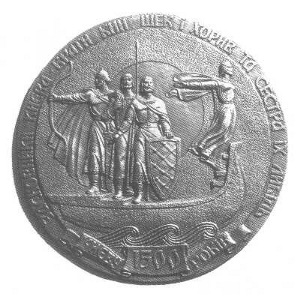 Commemoration Plaque of Kiev’s 1500th Anniversary Celebrated in 1982 In the Russian Primary Chronicle (the earliest existing written record of Kiev compiled c. 1113), Nestor the Chronicler relates the account (c. 482) of three brothers (Kyi, Shchek, Khoriv) and their sister (Lybed). Coming upon the east side of the Dnieper River and seeng the beautiful hills where Kiev now stands, they built a boat, crossed the river, decided to settle there, and named the place after the oldest son and chief, Kyi. This chronicle also records Kyi’s journey to Constantinople where he was received with honor. It is important to note that the Byzantines greatly delighted in escorting foreign leaders around their beautiful city and making a great show of their awe-inspiring churches and other magnificent buildings and achievements. It was their hope that these foreign leaders/dignitaries would convert to Christianity and take the faith back to their people. The Byzantine government had noted that when pagans converted to Christianity, they became less hostile and made treaty and trade negotiations more amicably. Part of these treaties contained clauses that permitted men from the foreign tribe/country to serve in the Byzantine military. This provided Constantinople with more men to fight their wars and often resulted in their converting to Christianity. If they lived and returned home, these men would bring knowledge of the Christian faith back to their family and friends. to be continued
Atlas of Russian History, Martin Gilbert, Dorset Press, New York, 1984 The Entry of the Slavs into Christendom, A. P. Vlasto, Cambridge University Press, New York, reprinted 2009 The Lives of the Holy Apostles, Trans. Reader Isaac E. Lambertsen & Holy Apostles Convent, Holy Apostles Convent, Buena Vista, Colorado, 1990 The Russian Primary Chronicle, trans. Samuel Hazzard & Olerd P. Sherbowitz-Wetzor Cross, The Mediaeval Academy of America, Cambridge, Massachusetts, 1973 
|
  
February 5th at 9am
March 5th at 9am April 2nd at 9am Pilgrimage May 7th at 9am June 4th at 9am Matins starts at 8am Knitters' Retreat
February 18-20, 2011
Contact Maria Floyd: 803-642-4402 OR Email her at mariajfloyd@gmail.com This retreat is for women 21 years of age and older. Due to limited space, we can only accommodate twelve women. If you plan to attend, come for the entire retreat. You need to have a project or projects that you can work on without help from other knitters. God willing, we will have a priest to serve Liturgy on Sunday morning. Youth Retreats
We will no longer be hosting youth retreats here.
These retreats are transitioning to Camp St. Thecla at the Diakonia Retreats Center www.campstthekla.org  FROM MARTHA'S KITCHEN SCALLOPS & PORTABELLAS
1/4 cup toasted sesame seed oil In a wok or large cast-iron skillet, heat oil and dissolve miso in oil. Add tamari sauce, string beans, water chestnuts mushrooms and ginger. When string beans and mushrooms are al dante, add scallops and almonds till done. Good over rice or noodles. Serves 8 |